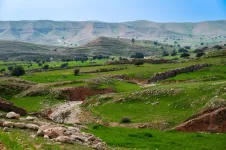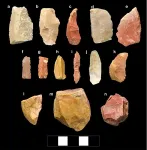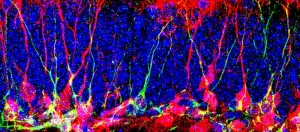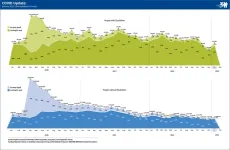(Press-News.org) A world-first model of paleoclimate and hydrology in Iran has highlighted favourable routes for Neanderthals and modern human expansions eastwards into Asia.
Published in PLOS ONE, the findings reveal for the first time that multiple humid periods in ancient Iran led to the expansions of human populations, opening dispersal route across the region, and the possible interactions of species such as Neanderthals and our own Homo sapiens.
Professor Michael Petraglia, a key researcher in the study, said historic humid periods resulted in massive changes to ecosystems and led the team to identify large lakes in areas that were formerly deserts.
“Conversely, during glacial periods this increased aridity would have led to the expansion of deserts, led to contractions, and the isolation of hominin populations,” said Professor Petraglia, who is the Director of Griffith’s Australian Research Centre for Human Evolution.
“This cycle of wetting and drying is shown for the first time in Iran.”
The research team, led by PhD candidate Mohammad Javad Shoaee from the Max Planck Institute for Geoanthropology in Germany, found that during Marine Isotope Stage (MIS) 5, a warm, humid period beginning roughly 130,000 years ago, lakes and rivers enabled two pathways for human groups.
One was a northern route through the Alborz and Kopet Dagh Mountains and north of the Dasht-I Kavir desert. The other route, first identified here, ran south along the Zagros Mountains before extending eastwards towards Pakistan and Afghanistan.
The researchers also found evidence for a potential northern route during MIS 3, beginning about 57,000 years ago, which, given artifacts attributed to multiple tool making groups, could have permitted interactions between modern humans and Neanderthals.
“These findings highlight the importance of Iran for our species’ dispersals out of Africa and ultimately around the globe,” said Professor Petraglia.
“As in other regions long considered too arid for early human occupations, such as the Arabian Peninsula, recent palaeoclimatic research is changing how we understand the human story and the role that changing climates have played.”
“We recognised a new southern route along the Zagros Mountains and extending eastwards towards Pakistan and Afghanistan. We found evidence for a potential northern route during MIS 3, which would have permitted hominin movements and species interactions in Southwest Asia,” Shoaee said.
To find out how human groups made their way into Iran, the team developed the first spatially comprehensive, high resolution palaeohydrological model for Iran.
They then compared their model, which showed when and where water was available, to the distribution of previously documented archaeological sites.
The result was a clear relationship between the availability of water and the evidence of human presence.
Not only does the current study help to explain the presence of previously documented sites, it also serves as a guide for future archaeological surveys in the region.
“Our paleohydrological analyses identified 145,354km of rivers and 115 paleolakes calculated from 6380 paleolake deposits. Only a handful of these paleolakes have so far been studied,” Shoaee said.
By focusing on regions where water once made human occupations possible, Professor Petraglia said “researchers could maximize the potential of finding archaeological sites".
END
Waxing and waning of environment influences hominin dispersals across ancient Iran
2023-03-01
ELSE PRESS RELEASES FROM THIS DATE:
Vitamin B5 could help improve red blood cell production in people with Myelodysplastic syndromes
2023-03-01
Queen Mary University of London and Francis Crick Institute press release
Under strict embargo: 19:00hrs GMT Wednesday March 1, 2023
Peer reviewed
Experimental study
Cells
Vitamin B5 could help improve red blood cell production in people with Myelodysplastic syndromes
Scientists from Barts Cancer Institute at Queen Mary University of London and the Francis Crick Institute, have uncovered why patients with a rare type of blood cancer suffer from ineffective red blood cell production, and how vitamin B5 could be combined with existing drugs to improve outcomes.
Myelodysplastic syndromes (MDS) are a type of blood cancer characterised ...
How to generate new neurons in the brain
2023-03-01
Some areas of the adult brain contain quiescent, or dormant, neural stem cells that can potentially be reactivated to form new neurons. However, the transition from quiescence to proliferation is still poorly understood. A team led by scientists from the Universities of Geneva (UNIGE) and Lausanne (UNIL) has discovered the importance of cell metabolism in this process and identified how to wake up these neural stem cells and reactivate them. Biologists succeeded in increasing the number of new neurons in the brain of adult and ...
Stress gene dysregulation found in kids after injury from abuse vs. accident
2023-03-01
Epigenetic changes in the regulation of a key gene in the body’s stress response system were detected in babies and young children with abusive injuries, as opposed to accidental, according to a pilot study published in the journal Pediatric Research.
The epigenome influences levels of gene expression in response to the physical, social and emotional environment, without altering the DNA sequence. Multiple studies in adults have found that traumatic and adverse childhood experiences are associated with epigenetic alterations in the FKBP5 gene, an important regulator ...
Researchers bioengineer an endocrine pancreas for type 1 diabetes
2023-03-01
BOSTON – In people with type 1 diabetes, the body’s immune system attacks and destroys insulin-producing β cells that control blood glucose levels and are part of a group of cells in the pancreas called pancreatic islets. In research published in Cell Reports Medicine, a team led by investigators at Massachusetts General Hospital (MGH), a founding member of Mass General Brigham, recently developed an efficient way to transplant pancreatic islets and demonstrated that the method can effectively reverse type 1 diabetes in nonhuman primates.
Pancreatic islet transplantation is a promising treatment approach for type 1 diabetes; however, current methods, ...
New UCF project seeks to advance human understanding of AI reasoning
2023-03-01
ORLANDO, March 1, 2023 — A University of Central Florida researcher has received funding from the U.S. Department of Energy (DOE) to enhance the current understanding of artificial intelligence (AI) reasoning.
The project focuses on developing algorithms to create robust multi-modal explanations for foundation, or large, AI models through the exploration of several novel explainable AI methods. The DOE recently awarded $400,000 to fund the project.
The project was one of 22 proposals selected for the DOE’s 2022 Exploratory Research for Extreme-Scale Science (EXPRESS) grant, which promotes the study ...
New study reveals parents’ concerns about their sexual and gender minority teens using prep for HIV prevention
2023-03-01
Since its approval in 2012, HIV pre-exposure prophylaxis, or PrEP, has shown promise in reducing HIV infection rates by preventing infection in high-risk HIV-negative people. However, research shows that only around three percent of sexual and gender minority (SGM) adolescents who are eligible for PrEP have used it.
In a new study, Christopher Owens, PhD, assistant professor in the Department of Health Behavior at the Texas A&M University School of Public Health, explores factors that may be associated with parents’ acceptance of their SGM adolescent using PrEP. The study, published in the journal AIDS ...
New mathematical model shows promising results for prostate cancer treatment
2023-03-01
A new mathematical model which aims to optimise treatment for prostate cancer has been developed by experts at the University of Portsmouth.
Prostate cancer is the second most common cancer among men worldwide and accounts for 26 percent of all new cancer cases in males in the UK.
Over the past few decades mathematical models of tumour growth have been used to better understand the disease, to make predictions and to guide new experiments and clinical trials.
Dr Marianna Cerasuolo, Senior Lecturer from the University’s School of Mathematics and Physics, ...
nTIDE February 2023 Deeper Dive: What’s driving historic highs for employment of people with disabilities?
2023-03-01
East Hanover, NJ – March 1, 2023. In this month’s nTIDE Deeper Dive Lunch & Learn Webinar we explored the factors underlying the unprecedented rise in the employment of people with disabilities during the COVID-19 pandemic while continuing to follow trends in the labor market. This webinar followed two key unemployment indicators–the number unemployed and the proportions of unemployed persons that are on temporary layoffs (i.e., furloughs), comparing trends for people with and without disabilities.
“In January, we saw a large increase in the proportion ...
Study forecasts tile drainage and crop rotation changes for nitrogen loss
2023-03-01
URBANA, Ill. – Midwestern agriculture contributes the vast majority of nitrogen in the Gulf of Mexico, causing an oxygen-starved hypoxic zone and challenging coastal economies. State and federal policies have tried for decades to provide solutions and incentives, but the hypoxic zone keeps coming back. A recent study from the University of Illinois offers a new way to understand Midwestern nitrogen dynamics and forecasts future nitrogen loads under various management scenarios across the region.
“Our model explains what's going on across 83 watersheds in the Midwest, providing a quantitative understanding of why certain watersheds ...
Vilcek Foundation announces open call for $150,000 in prizes to immigrant scientists
2023-03-01
In 2024, the Vilcek Foundation will award three Vilcek Prizes for Creative Promise in Biomedical Science of $50,000 each. The prizes recognize and celebrate the contributions of rising immigrant scientists in the United States whose work represents a significant contribution to their field. The Vilcek Foundation is hosting an open call for applications for the 2024 prizes; applications will be accepted through June 12, 2023, at 5:00 p.m. ET.
The Vilcek Prizes for Creative Promise are a part of the Vilcek Foundation Prizes program. Awarded ...




